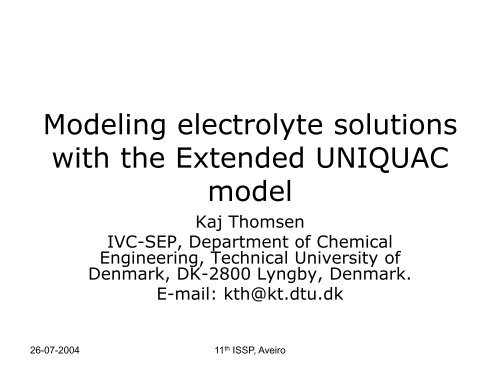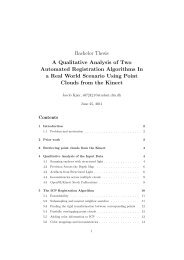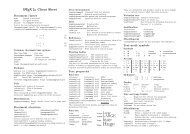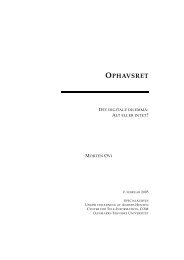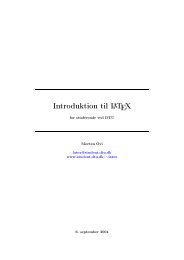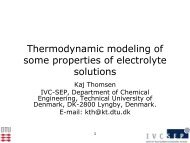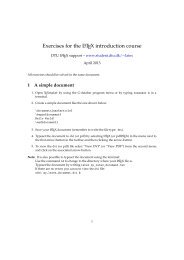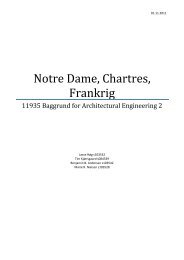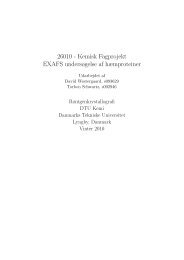Modeling electrolyte solutions with the Extended UNIQUAC model
Modeling electrolyte solutions with the Extended UNIQUAC model
Modeling electrolyte solutions with the Extended UNIQUAC model
You also want an ePaper? Increase the reach of your titles
YUMPU automatically turns print PDFs into web optimized ePapers that Google loves.
<strong>Modeling</strong> <strong>electrolyte</strong> <strong>solutions</strong><strong>with</strong> <strong>the</strong> <strong>Extended</strong> <strong>UNIQUAC</strong><strong>model</strong>Kaj ThomsenIVC-SEP, Department of ChemicalEngineering, Technical University ofDenmark, DK-2800 Lyngby, Denmark.E-mail: kth@kt.dtu.dk26-07-2004 11 th ISSP, Aveiro
Models for <strong>electrolyte</strong>s• Debye-Hückel electrostatic term– Pitzer– Electrolyte NRTL– <strong>Extended</strong> <strong>UNIQUAC</strong>• MSA electrostatic term– Equation of state for <strong>electrolyte</strong>s• Debye-Hückel / MSA26-07-2004 11 th ISSP, Aveiro
Standard states• Water is <strong>the</strong> solvent RT ln( x ); 10w w w w w x w1• Ions, non-<strong>electrolyte</strong>s, gases aresolutes* * * RT ln( x ); 1i i i i i xi0i26-07-2004 11 th ISSP, Aveiro
Relative permittivity90Relative permittivity of aqueous <strong>solutions</strong>Relative permittivity .80706050403020NaCl, Hasted et al, 1948Ethanol, Åkerlöf, 19321000 10 20 30 40 50 60 70 80 90 100Mass26-07-2004 11 th % soluteISSP, Aveiro
<strong>Extended</strong> <strong>UNIQUAC</strong>• Excess gibbs energy function– Debye-Hückel term– Standard <strong>UNIQUAC</strong> term• Activity coefficients and <strong>the</strong>rmalproperties are derived by standardmethods known from classical<strong>the</strong>rmodynamics26-07-2004 11 th ISSP, Aveiro
Model parameters• Standard <strong>UNIQUAC</strong> parameters– Volume parameter for each species– Surface area parameter for each species– Interaction energy parameter for eachpair of species• Temperature dependence of interactionenergy parameter• Number of parameters:• e<strong>UNIQUAC</strong> ~ eNRTL
Databank• Over 100,000 experimental data– Activity coefficient– Enthalpy of mixing– Heat capacity– Degree of dissociation– Gas solubility– Salt solubility– Liquid-liquid equilibrium– Vapor-liquid equilibrium26-07-2004 11 th ISSP, Aveiro
Parameter estimation• Critical review of data• Non-linear least squares optimization– Differences between experimental andcalculated values are minimized– The calculation of <strong>the</strong> differencedepends on <strong>the</strong> type of data– All data of same type weighted equally26-07-2004 11 th ISSP, Aveiro
Anchoring of parameters• No binary solution of one ion inwater• Parameters of ions are relative toeach o<strong>the</strong>r• The hydrogen ion is used as anchor– Parameters for <strong>the</strong> hydrogen ion aregiven fixed values26-07-2004 11 th ISSP, Aveiro
Thermal properties• Excess enthalpy is calculated from <strong>the</strong>temperature derivative of activitycoefficients.• By using <strong>the</strong>rmal properties in <strong>the</strong>parameter estimation a bettertemperature dependency of activitycoefficients is achieved• Clear distinction between temperaturedependency and concentrationdependency26-07-2004 11 th ISSP, Aveiro
Parameters• H + , Na + , K + , NH 4+, Ca 2+ , Mg 2+ , Mn 2+ , Fe 2+ ,Co 2+ , Ni 2+ , Cu 2+ , Zn 2+ , Ba 2+ , Sr 2+• F - , Cl - , Br - , NO 3-, SO 42-, HSO 4-, OH - , CO 32-,HCO 3-, S 2O 82-, SO 32-, HSO 3- , HPO 4- , H 2 PO 4-• H 2 O, CO 2 , NH 3 , SO 2 , C 12 H 22 O 11 , CH 3 OH,C 2 H 5 OH, n-C 3 H 7 OH, i-C 3 H 7 OH, n-C 4 H 9 OH,i-C 4 H 9 OH, s-C 4 H 9 OH, t-C 4 H 9 OH26-07-2004 11 th ISSP, Aveiro
Equilibrium calculations• Speciation equilibrium• +• Solid-liquid equilibrium• Vapor-liquid equilibrium• Liquid-liquid equilibrium26-07-2004 11 th ISSP, Aveiro
Speciation equilibriaNH 3 (aq)+H 2 O NH 4+ (aq)+OH - (aq)Equilibrium condition: NH H O NH OH3 2 4 - -a a- lnRT a a* * * 0 * *NH OH NH H O NH OH- -4 3 24-*NHH O3 226-07-2004 11 th ISSP, Aveiro
Solid-liquid equilibrium• At equilibrium, <strong>the</strong> chemical potentialof <strong>the</strong> pure crystalline salt(hydrate)equals <strong>the</strong> sum of <strong>the</strong> chemicalpotentials of <strong>the</strong> salts components insolution• It is required that o<strong>the</strong>r salts are notsupersaturated.26-07-2004 11 th ISSP, Aveiro
Vapor-liquid equilibrium• Equality of chemical potential in gasphase and in liquid phase (Gamma-phimethod)• Gas phase fugacities are calculated<strong>with</strong> <strong>the</strong> Soave-Redlich-Kwongequation of stateCO ( g) CO ( aq)2 2 ˆ ln RT ln y P RT x 0, g* *CO CO CO CO CO CO2 2 2 2 2 226-07-2004 11 th ISSP, Aveiro
Liquid-liquid equilibrium• Equilibrium between component i inphase I and phase IIIi RT ln( x ) RT ln( x )* * I * * IIi i i i i i• Here <strong>the</strong> activity product of salts ra<strong>the</strong>rthan <strong>the</strong> activities of <strong>the</strong> individual ionsions are comparedIIi( x) ( x)* I * IIi i i i26-07-2004 11 th ISSP, Aveiro
Standard state properties• The numerical values of standard statechemical potentials are needed beforeequilibrium calculations can be made• Such values for most solutes and manysalts are found in <strong>the</strong> NBS tables• Those not found have to be fitted toexperimental data• Temperature dependence calculated <strong>with</strong>classical <strong>the</strong>rmodynamic method26-07-2004 11 th ISSP, Aveiro
908070<strong>Extended</strong> <strong>UNIQUAC</strong> <strong>model</strong>Experimental data--60Temperature °C50403020100-10IceMn(NO 3 ) 2·6H 2 OMn(NO 3 ) 2·4H 2 OMn(NO 3 ) 2·2H 2 OMn(NO 3 ) 2·H 2 O-200 10 20 30 40 50 60 70 80 90 100Mass percent Mn(NO 3 ) 226-07-2004 11 th ISSP, Aveiro
120100Ca(OH) 2Temperature °C80604020CalculatedExperimental00 0.05 0.1 0.15 0.2Mass percent Ca(OH) 226-07-2004 11 th ISSP, Aveiro
K2CO3 salt fractionNa2CO310.90.80.70.60.50.40.30.20.10IceNa 2 CO 3·10H 2 ONaKCO 3·6H 2 ONa 2 CO 3·7H 2 OK 2 CO 3·½H 2 O<strong>Extended</strong> <strong>UNIQUAC</strong> <strong>model</strong>Experimental dataNa 2 CO 3·H 2 ONa 2 CO 3·K 2 CO 3Na 2 CO 3-40 -30 -20 -10 0 10 20 30 40 50 60 70 80 90 100 110Temperature, °C26-07-2004 11 th ISSP, Aveiro
9080<strong>Extended</strong> <strong>UNIQUAC</strong> <strong>model</strong>Experimental data__5.9 molal NH 380°CCO2 partial pressure, bar70605040300.6 m1 m6.8 molal NH 32 molal 4.1 mNH 39 molal NH 312 molal NH 3201000 2 4 6 8 10CO 2 mol kg -126-07-2004 11 th ISSP, Aveiro
9010010010090H 2 O15°C2080807025°C307050°C406060504075°C6050504070303080Thompson and Vener (1948)20Armstrong and Eyre (1910)90Gerardin (1865)Schiff (1861)10KNO 3<strong>Extended</strong> <strong>UNIQUAC</strong> <strong>model</strong>100Series20Series30 10 20 30 Series4 40 50 60 70 80 90 100C 2 H 5 OH2010026-07-2004 11 th ISSP, Aveiro
100.0090.0080.0070.0060.0050.0040.0030.0020.00K 2 CO 310010.009080706050403010100H 2 O0 10 20 30 40 50 60 70 80 90 10026-07-2004 11 th ISSP, Aveiroiso-propanol0.00Iino et al. (1971)Do & Park (1974)<strong>Extended</strong> <strong>UNIQUAC</strong>Series2Series330 °C Series4Series72009080706050403020100
xy - diagram for iso-propanol - water, 1 bar10.90.8y iso-propanol0.70.60.50.40.30.20.10<strong>Extended</strong> <strong>UNIQUAC</strong> <strong>model</strong>Marzal et al. (1996)Saturation <strong>with</strong> K2CO30 0.1 0.2 0.3 0.4 0.5 0.6 0.7 0.8 0.9 1x iso-propanol26-07-2004 11 th ISSP, Aveiro
Concluding remarks• The <strong>Extended</strong> <strong>UNIQUAC</strong> <strong>model</strong> is avery simpel <strong>model</strong>, <strong>with</strong> only binaryparameters, yet it is able to describe<strong>the</strong> phase behavior of <strong>electrolyte</strong><strong>solutions</strong> <strong>with</strong>in <strong>the</strong> experimentalaccuracy• <strong>Modeling</strong> of <strong>electrolyte</strong>s under highpressure will be presented by AdaVilafafila Garcia on her poster26-07-2004 11 th ISSP, Aveiro


